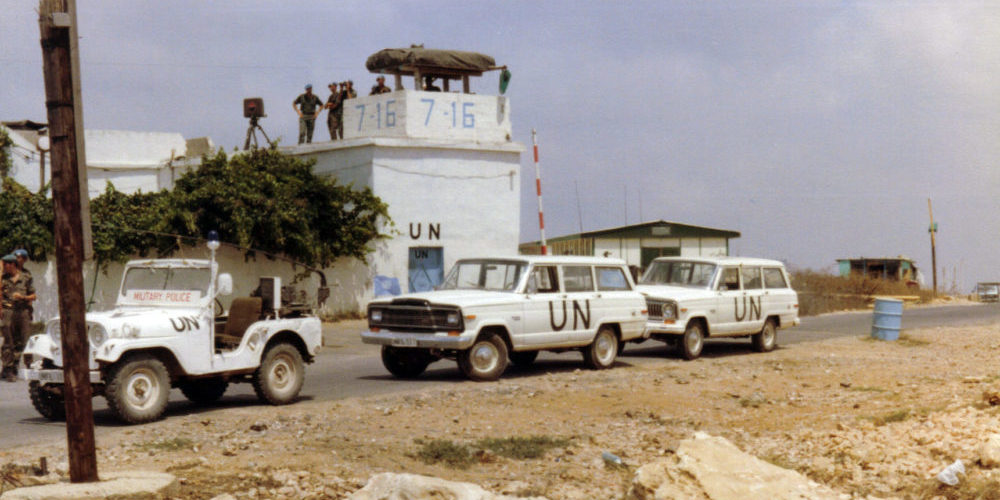
CSU Animal Sciences Professor Thomas Sutherland accepted the job of Dean of Agriculture at the American University of Beirut during a time of relative stability, under a peace brokered by the United Nations and the U.S. The peace and stability was short-lived, however, as CSU Emeritus Professor of History William Griswold explains. Photo by Al Yatun
When CSU professor Tom Sutherland accepted the job of Dean of Agriculture at the American University of Beirut in 1983, he knew he was stepping into a cauldron of anti-American feeling in Lebanon. To Tom the opportunity to serve in Lebanon was a challenge. He had no particular political prejudices but assumed all people valued science and peace.
What he did not understand was the extraordinary hatred and suspicion most Arabs had of Western governments. The average Arab simply saw the West as bent on interference in Middle East governance and the continuing support of the policies of the state of Israel. These beliefs permeated the region, filling many Arabs with questions. Why would an American scholar-educator want to help the very people whom his Western forces were undermining and controlling?
Sutherland thrived on the challenge. He ignored the hatred and the dangers that might face him. He carefully considered the options and then, with his wife Jean, made the decision to accept. After all, he would be teaching in one of the most prestigious universities in the Middle East.
He read deeply into the events and politics of the region, how the Israelis had invaded southern Lebanon in 1982. He knew that much of Lebanon was Shi’a land, that the Shi’a had long been ill-treated by the national power structure, that many Shi’a had been murdered by Christian Maronites in the Beirut suburbs of Sabra and Shatila while Israeli army personnel looked on.
Yet, a peace had been brokered by the U.S. and the United Nations. Late in the year Israeli forces had returned home. A certain stability now existed and could continue if good people tried. Beirut could flourish. By 1983 it seemed one could take up the challenge with some safety to work for education not war. Tom decided it was worth a try. At the same time he knew he was not alone but had a remarkable leader with whom he would work: the newly appointed president of AUB, Malcolm Kerr.
Kerr had long known of the opportunities for making a difference in the lives of the young Arab men and women through the century-old university of American influence for peace. Born in Beirut, the son of an AUB professor, Kerr had become a major writer of Middle East political science. He recruited Tom, a fellow Scot, as a fine teacher, and one dedicated to the objectives of the school. He gave Tom free rein to develop a first-rate curriculum, with the latest application of science to the growing of animals and crops. What could be more useful in the movement toward a peaceful reconstruction of Lebanon?
Even today, most Americans have difficulty understanding the intense frustration that permeated Lebanon. From earliest days of French involvement after the first World War to the Israeli invasion of 1982, Lebanon suffered internal division and unequal governance. A major change occurred in the late 1970s when the Lebanese Christian leadership moved toward alignment with Israel. This alarmed Syria, then a major Sunni Arab power and led it to move militarily into Lebanon. The Israeli invasion of Lebanon thus provoked the normally quiescent Shi’a majority to a unified anger resulting in a sectarian bonding they called the Islamic Jihad. These Shi’ites hated Israel, hated the Christian Lebanese leadership, hated the rich Sunni Muslims of Beirut, and felt totally isolated.
After 1979 when the Iranians deposed their Shah, the United States imposed sanctions against the new Islamic Republic of Iran, sanctions that included freezing billions of dollars’ worth of assets in American banks.
In the early 1980s, the Islamic Jihad sought help from their co-religionists now in power in Iran. They could access professional military leadership from the Iranian Revolutionary Guard. They could take on a specific mission: eliminate Western power in Lebanon and its support of Israel. They could easily take prominent Westerners hostage to increase their notoriety; the ransoms paid would increase their funds. They could — and would — murder prominent Westerners in Lebanon.
Thus, the challenges that Tom had worked so hard to overcome became overwhelming in 1984. That year a still-unknown group murdered President Kerr. That tragedy would soon be compounded. Returning to AUB from a trip to New York, Tom himself was taken prisoner. He always thought it had been a mistake, since Islamic Jihad, or Hezbollah as the group was also known, really wanted the newly appointed president. But it was a mistake sorely paid for.
For all his desire to serve, to accept the challenge, the many local and international forces of hatred denied Tom the freedom to teach. He spent six years imprisoned, bound and blindfolded by Hezbollah, backed by the Iranian government.
In the end, the Iranians determined that keeping the Americans incarcerated was more trouble than it was worth. Apparently, the chief of the Iranian Republic, Ayatollah Khomeini himself, gave the permission to release the American prisoners.
Tom and several others held by Hezbollah came home in 1991. A lawsuit against Hezbollah for their treatment was finally settled in 2001, and Sutherland received $35 million against the still-frozen Iranian assets.
William Griswold is an emeritus professor of history at Colorado State University. He was Tom Sutherland’s friend since 1965.